What are the different types of skin cancer?
Did you know that skin cancer is the most common type of cancer, accounting for 80 per cent of all cancers in Australia and attributing to around 2,000 deaths nation-wide each year? Melanoma can affect people of any age; in fact, it is the most common cancer in people aged 15 to 44 years. Other types of skin cancer such as basal cell carcinoma are more common on the sun-exposed skin of people aged over 55. So what are the differences between the various skin cancer types and how can you tell a normal mole from a cancerous one?
Harmless lesions
These lesions are mostly harmless, but you should see your doctor if any new lesion appears on your skin after age 55.
Freckles
Freckles are harmless coloured spots of 1 to 10mm. Most freckles develop in childhood and then fade into adulthood, completely disappearing in older age.
Moles
Moles are also coloured spots of 1 to 10mm. They are uniform in shape and colour, may be raised and have uneven borders.
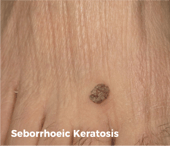 Seborrhoeic keratoses
Seborrhoeic keratoses
These wart-like spots sit on top of the skin and usually develop by the age of 60. The colour can be pale, orange or black. The size varies from a few millimetres to 2cm.
High-risk lesions
These lesions are not cancerous but have the potential to become cancerous over time. They should be closely monitored by your doctor for any changes.
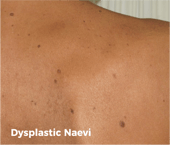 Dysplastic naevi
Dysplastic naevi
These odd-shaped moles are benign but might indicate a greater risk of developing melanoma. They have irregular borders, are usually 5 to 10mm wide, and are uneven in colour with shades of brown and pink.
Solar keratoses
These non-cancerous "sun spots" are a warning sign that the skin has been damaged by the sun and that you may develop skin cancer, especially if the spots become lumpy or tender. Typical characteristics are red, scaly areas which can sting if scratched.
Skin cancers
These lesions are malignant.
Basal cell carcinoma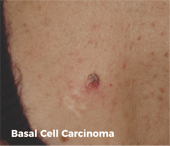 This is the most common but least dangerous form of skin cancer which accounts for about 66 per cent of all skin cancers. Basal cell carcinoma usually appears as a lump or scaling area on areas often exposed to the sun, including the head, face, neck, shoulders and back. It often grows slowly over months or years but does not spread to other parts of the body. The small, round spots are usually red, pale or pearly in colour and can become ulcerated like a sore, bleed and fail to heal. Some spots can look like a patch of eczema.
This is the most common but least dangerous form of skin cancer which accounts for about 66 per cent of all skin cancers. Basal cell carcinoma usually appears as a lump or scaling area on areas often exposed to the sun, including the head, face, neck, shoulders and back. It often grows slowly over months or years but does not spread to other parts of the body. The small, round spots are usually red, pale or pearly in colour and can become ulcerated like a sore, bleed and fail to heal. Some spots can look like a patch of eczema.
Squamous cell carcinoma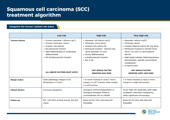 This skin cancer is not as dangerous as melanoma but if it is left untreated, it can spread to other body parts and become fatal. Most people who die from this type of skin cancer are elderly or have a suppressed immune system, such as those who have had organ transplants. It is very rare in children and young adults. Squamous cell carcinoma grows over several months and usually appears on areas most often exposed to the sun. Typical characteristics include thick, red and scaly spots.
This skin cancer is not as dangerous as melanoma but if it is left untreated, it can spread to other body parts and become fatal. Most people who die from this type of skin cancer are elderly or have a suppressed immune system, such as those who have had organ transplants. It is very rare in children and young adults. Squamous cell carcinoma grows over several months and usually appears on areas most often exposed to the sun. Typical characteristics include thick, red and scaly spots.
Melanoma 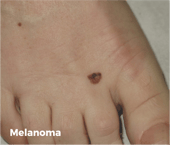 This dangerous form of skin cancer can spread to other parts of the body. It can appear anywhere on the body, including in areas not usually exposed to the sun such as your eyelids, under your nails, on the soles of your feet, and even inside your mouth. Melanoma usually appears as a new or existing spot which changed in colour, shape or size. It has irregular borders and more than one colour.
This dangerous form of skin cancer can spread to other parts of the body. It can appear anywhere on the body, including in areas not usually exposed to the sun such as your eyelids, under your nails, on the soles of your feet, and even inside your mouth. Melanoma usually appears as a new or existing spot which changed in colour, shape or size. It has irregular borders and more than one colour.
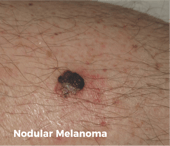
Nodular melanoma
This aggressive type of melanoma will spread to other body parts if left untreated. It may be red, pink, black or brown in colour. It is usually a dome shaped, raised lump which grows in size quickly and may bleed or crust.
Rare skin cancer
Merkel cell carcinoma
Merkel cell carcinoma is a rare type of skin cancer that usually appears as a flesh-coloured or bluish-red nodule, often on your face, head or neck. It most often develops in older people, and long-term sun exposure or a weak immune system may increase your risk of developing it. Merkel cell carcinoma tends to grow fast and spread quickly to other parts of your body. The first sign is usually a fast-growing, painless nodule on your skin.
Skin cancer can develop in anyone, no matter your skin type or age, so it is vital to use daily sun protection and get regular skin checks. The good news is that most skin cancers can be prevented or found early. Early detection is vital for the best treatment outcomes.
- Tags:
- Risks
